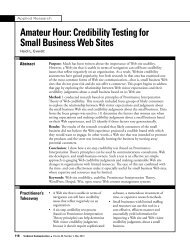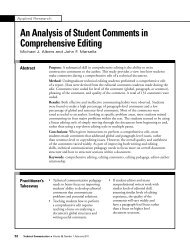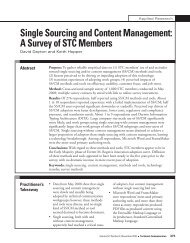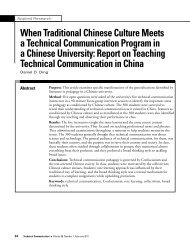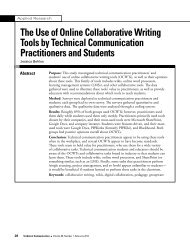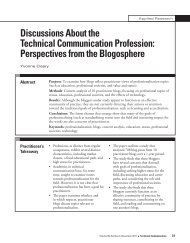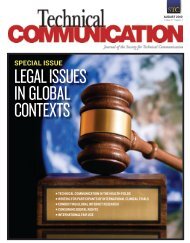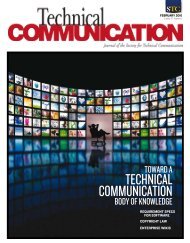SPECIAL ISSUE
Download: November 2011 - Technical Communication - Society for ...
Download: November 2011 - Technical Communication - Society for ...
- No tags were found...
You also want an ePaper? Increase the reach of your titles
YUMPU automatically turns print PDFs into web optimized ePapers that Google loves.
Applied ResearchThe First Wave (1953–1961) of the Professionalization Movementvital to the growth of the profession” (Clark, 1956, p.2; Warnock, 1953). Their constitution stated that theorganization’s primary objective was “to advance theprofession” through such activities as developing “aliterature of the profession” and promoting professionalethics (“TWE constitution,” 1955, p. 8). The BostonbasedSociety of Technical Writers (STW), also started in1953, had the same general objective in mind. As theirpresident declared two years after STW’s formation,“Now that organization as a national professionalsociety, with graded membership, is complete, we arefree to apply our energies directly to our basic program:developing the profession” (Flint, 1955, p. 1). One ofthe purposes of the Technical Publishing Society (TPS),started on the West Coast in 1954, was “to promote theprofession by establishing and maintaining minimumrequirements of professional practices” (Van Hagan,1954, p. 1). These three organizations would eventuallymerge to become the Society of Technical Writers andPublishers (STWP), the former name of STC. Yearslater, the editor of STC’s Technical Communicationwould remind his readers that “these [early] societieswere established and were supported precisely becausethey were seen as a necessary step on the path towardprofessionalism” (Smith, 1980, p. 2).Both Savage (1999) and Carliner (2003) havesuggested that we have too many organizations (e.g.,STC, PCS, ATTW) to pose a unified front in thestruggle for professionalization. Carliner (2003), in fact,sees cooperation, if not consolidation, as necessary tomove to “the next level” (p. 98). The founders of ourprofession—including Samuel A. Miles (Figure 2)—grappled with the same problem in the 1950s. Miles(1955), who had started an organization in New YorkCity in 1954, wrote:One thing is certain: the technical writer, bywhatever name we may call him, and underwhatever definition we may formalize, is here to stay.The continued growth of technical writing is proofof this fact. As I write these words, another group—the twelfth, thirteenth, or fourteenth, dependingon the definition of a group—has come to myattention. It is the Technical Writing ImprovementSociety, of Los Angeles….TWIS is the third or fourth group ambitiousenough to consider itself the nucleus of a nationalgroup. All this activity means that there is hope thatwe shall soon get together and that the “Tower ofBabel” which we are creating will be a firm structurebased on mutual understanding. (pp. 3–4).In late 1955, Miles’ organization merged with TWEto become TWE’s New York chapter (Kleinman, 1989).This was the first in a series of consolidations that wouldeventually lead to the creation of STC.Figure 2: Samuel A. Miles(1916–1982), cofounder and vicepresident of Miles-Samuelson, atechnical publishing business inNew York City, and founder(1954) of the New York-basedSociety of Technical Writersand Editors, an independentorganization that merged withTWE in late 1955 to become TWE’s first and largest (NewYork) chapter. As early as 1949, Miles had explored thepossibility of creating a “society” of scientific and technicalcommunicators within the framework of the AmericanAssociation for the Advancement of Science (Miles, 1951;“Operation,” 1951; “Sam Miles,” 1955). Photo from the Fall1955 issue of the TWE Journal.A major step toward unification was taken in 1957when TWE and STW merged to form the Societyof Technical Writers and Editors (STWE). In thediscussions leading up to this merger, TWE and STWargued about membership qualifications and gradesof membership. TWE wanted to follow its practice ofallowing anyone to join who had a professional interestin technical communication, while STW wanted torestrict membership to technical writers, technicaleditors, and teachers of technical writing, excludingillustrators, production people, and especially technicallibrarians. Whereas TWE did not want membershipgrades, STW wanted membership to be stratified intomembers, senior members, and fellows (Malone, n.d.).As one TWE member complained, “[STW officers] haveset up these classifications so that they can be in the topgrades and they are unwilling to become just ordinarymembers. They want to remain stars” (TWE, 1956, p.52). After several months of negotiations (Figure 3), the288 Technical Communication l Volume 58, Number 4, November 2011



